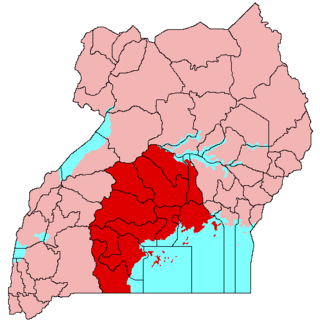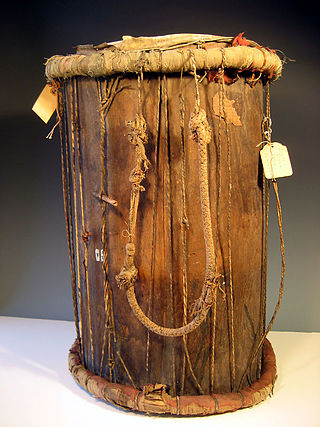
Buganda is a Bantu kingdom within Uganda. The kingdom of the Baganda people, Buganda is the largest of the traditional kingdoms in present-day East Africa, consisting of Uganda's Central Region, including the Ugandan capital Kampala. The 14 million Baganda make up the largest Ugandan region, representing approximately 16% of Uganda's population.

Bunyoro, also called Bunyoro-Kitara, is a traditional Bantu kingdom in Western Uganda. It was one of the most powerful kingdoms in Central and East Africa from the 16th century to the 19th century. It is ruled by the King (Omukama) of Bunyoro-Kitara. The current ruler is Solomon Iguru I, the 27th Omukama.
Omukama wa Bunyoro is the title given to rulers of the East African kingdom of Bunyoro-Kitara. The kingdom lasted as an independent state from the 16th to the 19th century. The Omukama of Bunyoro remains an important figure in Ugandan politics, especially among the Banyoro people of whom he is the titular head. He is closely related to the Omukama of Tooro Kingdom.

Culture of Uganda is made up of a diverse range of ethnic groups. Lake Kyoga forms the northern boundary for the Bantu-speaking people, who dominate much of East, Central, and Southern Africa. In Uganda, they include the Baganda and several other tribes

The Tooro Kingdom is a Bantu kingdom located within the borders of Uganda. The current Omukama of Tooro is King Oyo Nyimba Kabamba Iguru Rukidi IV. King Oyo Nyimba Kabamba Iguru Rukidi IV took to the throne of Tooro kingdom in 1995 at the age of just three years, after the death of his father Omukama Patrick David Matthew Kaboyo Rwamuhokya Olimi III on August 26, 1995, at the age of 50.

In Uganda the most spoken language in the capital city is Luganda, followed by English, as all schools in Uganda use it in their studies due to the introduction of English during the colonial period. English is also the language of business and judicial matters. Most spoken after Luganda and English is Swahili. This language is more common in neighbouring Kenya and Tanzania. Swahili is taught in schools as an optional additional language and it is mostly spoken by the Ugandan army. In 2005, there were talks to include Swahili as the second official language as it was seen as neutral, however this is still not ratified by the government. Swahili is used among some communities bordering South Sudan and Kenya.

The Iteso are a Nilotic ethnic group in eastern Uganda and western Kenya. Teso refers to the traditional homeland of the Iteso, and Ateso is their language.

The Nyoro people, also known as Banyoro are a Bantu ethnic group native to the kingdom of Bunyoro in Uganda. They live in settlements on a well-watered and fertile plateau. Banyoro are closely related to other Bantu peoples of the region, namely the Batooro, Banyankole, Bakiga and the Bahema peoples.
Tooro or Rutooro is a Bantu language spoken mainly by the Tooro people (Abatooro) from the Tooro Kingdom in western Uganda. There are three main areas where Tooro as a language is mainly used: Kabarole District, Kyenjojo District and Kyegegwa District. Tooro is unusual among Bantu languages as it lacks lexical tone. It is most closely related to Runyoro.
Kiga people, or Abakiga, are a Bantu ethnic group native to south western Uganda and northern Rwanda.
Articles related to Uganda include:

Rwenzururu is a subnational kingdom in western Uganda, located in the Rwenzori Mountains on the border with the Democratic Republic of the Congo. It includes the districts of Bundibugyo, Kasese and Ntoroko. Rwenzururu is also the name given to the region the kingdom is located in.

Kitara was an ancient legendary state that covered significant parts of western Uganda and is regularly mentioned in the oral traditions of the Banyoro, Batooro and Banyankole.
Queen Best Kemigisa Akiiki is the Queen Mother of the Tooro Kingdom, based in Fort Portal city, Uganda. She is mother to Rukirabasaija Oyo Nyimba Kabamba Iguru Amooti Rukidi IV, the reigning Omukama of Tooro.
Godfrey Mwakikagile is a Tanzanian scholar and author specialising in African studies. He was also a news reporter for The Standard — the oldest and largest English newspaper in Tanzania and one of the three largest in East Africa. Mwakikagile wrote Nyerere and Africa: End of an Era — a biographical book on the life of former Tanzanian President Julius Nyerere set in the backdrop of Africa's early post-colonial years and the liberation wars in the countries of southern Africa in which Nyerere played a major role.

The medieval history of the Serer people of Senegambia is partly characterised by resisting Islamization from perhaps the 11th century during the Almoravid movement, to the 19th century Marabout movement of Senegambia and continuation of the old Serer paternal dynasties.

The Tooro people, also known as Batooro or Toro people are a Bantu ethnic group, native to the Tooro Kingdom, a subnational constitutional monarchy within Uganda.

Bigwala is a genre of ceremonial music and dance of the Busoga Kingdom in Uganda centered around gourd trumpets.

Ugandan nationality law is regulated by the Constitution of Uganda, as amended; the Uganda Citizenship and Immigration Control Act; and various international agreements to which the country is a signatory. These laws determine who is, or is eligible to be, a national of Uganda. The legal means to acquire nationality, formal legal membership in a nation, differ from the domestic relationship of rights and obligations between a national and the nation, known as citizenship. Nationality describes the relationship of an individual to the state under international law, whereas citizenship is the domestic relationship of an individual within the nation. Commonwealth countries often use the terms nationality and citizenship as synonyms, despite their legal distinction and the fact that they are regulated by different governmental administrative bodies. Ugandan nationality is typically obtained under the principal of jus sanguinis, i.e. by birth to parents with Ugandan nationality. It can be granted to persons with an affiliation to the country, or to a permanent resident who has lived in the country for a given period of time through naturalisation or registration.

Firinda is a Ugandan sauce, made from uncoated mashed beans that originates from Western Uganda among the Batooro, Banyoro and Bakonzo. It is also known as Madakwa by the Congolese. It is a sauce that symbolises hospitality, served at different occasions including traditional marriage ceremonies, restaurants and cultural rituals.













